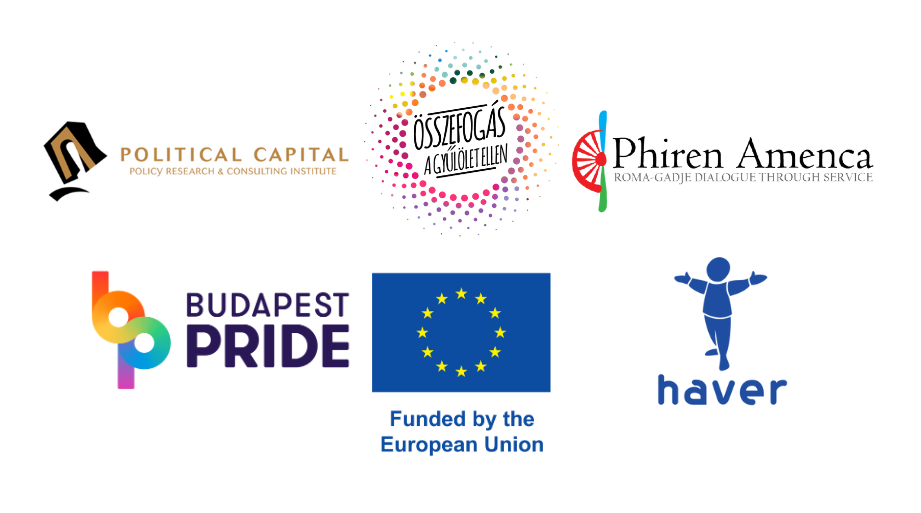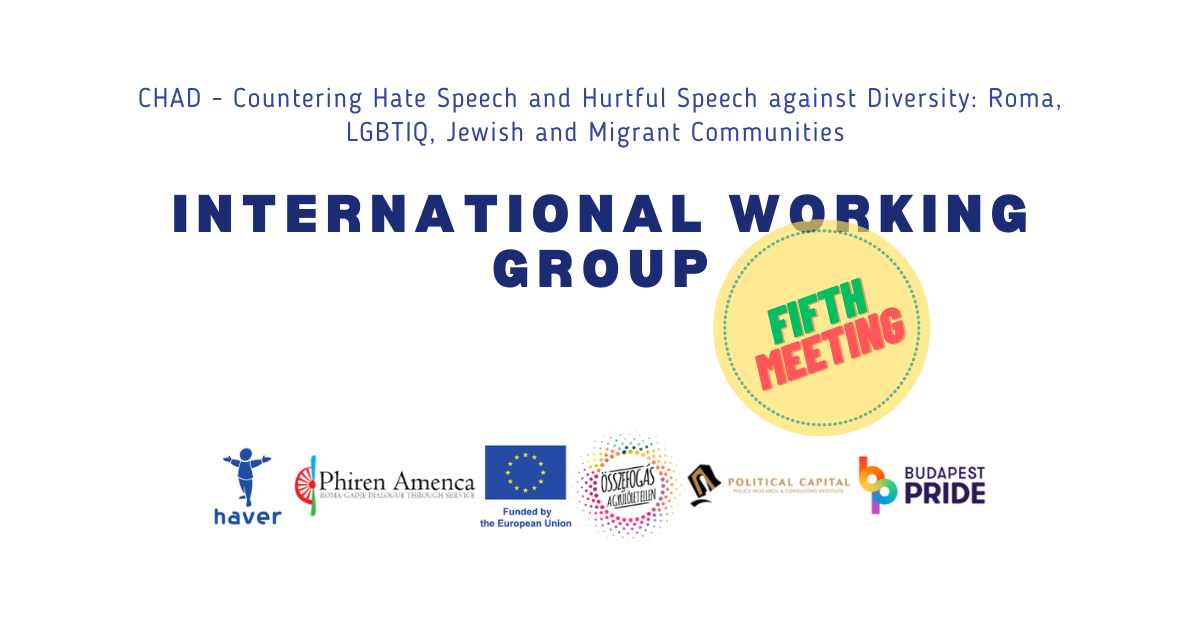May 23, 2023 – Online
The international working group, formed in the frame of the CHAD project, had its fifth meeting on 23 May 2023. The meeting aimed to address the possible levels and forms of hate speech regulations and the ways of countering hate speech.
Two presentations took place at the meeting, one from Judit Bayer, who presented current forms and levels of hate speech regulations on the EU level, and one from Menno Ettema, who presented non-legal forms and tools against hate speech.
Forms and levels of hate speech regulation on the EU level – Judit Bayer
Dr. habil. Judit Bayer is a Senior Research Fellow at the Institute for Information, Telecommunication and Media Law, University of Münster, Germany; associate professor in the Department of Communication of the Budapest Business University, Hungary.
There are hard and soft laws regulating hate speech on the EU level. One of the examples of soft laws is the new regulatory initiative for a more inclusive and better-connected EU, which aims to amend the Treaty of the European Union. Hate speech is always present and will always be present; the question is who sets the limits in society. Laws can be a good way, but they have a limited reach. Since democracies were also established to protect the freedom of speech and the rights of minorities, it is difficult to set a balance to protect both. In this era, we are facing an age of transition in communication; hate speech is present both online and offline (Trump’s campaign, Brexit, Covid-19), and there are international networks of hate speech and xenophobia. Good regulation on hate speech does not necessarily take the form of criminal law.
The new legislative initiative (soft law)
The European Commission, with the support of the Parliament, plans to extend the list of European crimes in the Treaty of the European Union (Art. 83 TFEU), to include hate crimes and hate speech. The purpose of this initiative is to give the competence to EU institutions to later pass secondary legislation on hate speech and hate crime. EU institutions have competences only in issues the member states have explicitly given them the right to legislation. The envisaged secondary legislation would take the form of a directive and would set the minimum rules to define criminal offences and sanctions. The new initiative would also extend and harmonise the list of protected characteristics, such as gender, sexual orientation, age, and disability. The maximum sanctions for hate crimes would be 1-3 years of prison time. The Treaty amendment would close gaps in the current hate speech laws by allowing to criminalise offline hate speech and extending protected features to include (gender, sexual orientation, age, and disability). Besides, the EU would have the competence to create further legislation on hate crime and hate speech in the future. However, the likelihood of having this amendment is rather low because adding gender and sexual orientation as protected features would be disapproved by Hungary, Poland, and the Czech Republic, which still withhold their support in the Council.
There are already frameworks and initiatives against hate crimes and hate speech. For instance, the Framework Decision on Combating Racism and Xenophobia (2008/913/JHA) (this is also hard law) only covers racism and xenophobia. In 2016 a voluntary Code of Conduct was created to tackle online hate speech, which is partly a response to Trump’s campaign and Brexit. This Code of Conduct is very basic and not that effective. However, the Code of Practice on Disinformation is a detailed tool that provides measures for service providers. Unfortunately, this is also voluntary; thus, providers can cherry-pick what they would adhere to. Once they have signed the commitments, they must follow due diligence, and after an indirect auditory process, they can be fined if they fail to do so. Besides, the current Article 83 contains some possibilities to enact secondary legislation on cybercrime, which includes online illegal content. Cybercrime is also regulated under the Council of Europe’s Convention on Cybercrime of 2001 and the Protocol on Racism and Xenophobia. The Audiovisual and Media Services Directive (AVMSD) prohibits violence and hatred against the extended list of protected features, but it is for video-sharing providers only.
Digital Services Act (hard law)
The Digital Services Act (DSA) is based on the E-commerce Directive, which orders that service providers shall remove illegal content that they become aware of. The DSA is more elaborate; it has added features, such as the Good Samaritan rule, which means that even if the service provider edits or moderates content, it does not create a basis for its responsibility. This Regulation applies directly to providers, not merely to member states, and it has detailed procedural rules with deadlines and mandatory reporting. These features make this regulation more effective, and with various complaint management structures, the freedom of speech is better protected. DSA defines illegal content as content that is illegal in any Member State. Service providers must report serious criminal offences to authorities. The DSA orders that notifications by ‘trusted flaggers’, which can be civil organisations acting as whistleblowers, get priority. Civil organisations can apply for this role through the Digital Services Coordinators. Lastly, the DSA heavily fines service providers who do not adhere to the regulation.
Different measures under the DSA can be used against hate speech: removing and blocking content; downgrading content – so it is out of the scope of most people’s attention; suspending or terminating the service for the user; suspending or eliminating the user’s account; or demonetising creators for spreading fake news or hate speech.
Some might argue that these regulations lead to legal censorship, but the presenter disagrees. Classic liberal thinkers argued that society would work hate speech out, and the truth will prevail. But this can only happen if the battlefield is equal, and it is currently not (because of sponsorships and algorithms); thus, the EU’s main goal is to create an equal playing field. Cancel culture in this regard is a double-edged sword. In the Anglo-Saxon world, governments assumed that social censorship would prevail and hate speech would become inevitably isolated. However, as we can see, this assumption does not work under any circumstances, as it did not work in Germany in the 1930-40s. Especially in the ages of transition, democratic governments should create laws that defend the democratic values of the society. When people in leadership positions endorse hate speech, whether online or offline, its effect multiplies. Laws and policies cannot turn back already existing discriminative policies, but they may prevent hate speech from becoming mainstream. Therefore, laws should be directed towards the “nodes” of hate speech, such as political parties and organisations, politicians, persons of authority, perhaps influencers, and not ordinary private individuals. A good example of this is that EU parties will not get funding from the EU if they use hate speech in their rhetoric.
Non-legal measures against hate speech – Menno Ettema
Menno Ettema is a Programme Manager of the No Hate Speech and Cooperation Unit at the Anti-Discrimination Department of the Council of Europe.
The Council of Europe (CoE) was established to protect human rights, democracy and the rule of law. There are 46 member states, including all EU member states. The Council’s instruments include standard setting through conventions and recommendations, monitoring, and cooperation.
There is a new recommendation, commonly agreed upon by all the member states (Recommendation CM/Rec(2022)16[1] of the Committee of Ministers to member States on combating hate speech) in place, which provides a definition of hate speech that covers the three different levels of severity. It provides guidance on legal and non-legal measures. Its legal framework includes criminal, civil and administrative laws and legislation regarding online hate speech. The recommendation also provides guidelines for member states and key actors, including private businesses, media, political bodies, civil society organisations and other actors. These actors all have their own roles to play, such as:
- awareness-raising, education, and training for businesses and police forces;
- support for those “targeted by hate speech” and victims;
- monitoring and analysing hate speech;
- national coordination and international cooperation.
To implement the new recommendation, two committees – CDADI (The Steering Committee on Anti-Discrimination, Diversity and Inclusion) and CDMSI (Steering Committee on Media and Information Society) – are working together. Additionally, there will be cooperation projects to assist member states and follow-ups. A review report on promising practices at the national level is due by 2024, and a review report on the implementation of the Recommendation by member States is due in 2027.
The Council of Europe provides cooperation programmes. For example, a systematic mapping approach, where CoE brings different actors together and asks them to map the ecosystem of hate speech, with this way it can identify gaps and create more effective action plans and national strategies. The Council of Europe also organises online courses on combating hate speech and hate crime and developed manuals for law enforcement on policing hate speech. The CoE also provides guides and tools to design and implement effective awareness-raising and educational initiatives, such as the No Hate Speech Movement or Block the Hatred, Share the Love (in the Western Balkans). Another example of these initiatives is the We Can 4 human rights speech (website: Toolkit for human rights speech (coe.int)). This online platform includes: the hate speech calculator, which is an assessment tool that helps to identify the severity of hate speech and the reaction to it; “human rights narrative builder” tool that allows you to define your arguments for human rights on a particular topic/issue; and the online tool-box will help you develop a communication strategy. This communication strategies toolbox also provides links to other effective tools, monitoring and helps people with methods to collect data from online platforms. The discussions following the presentation with all involved reflected on the role of Artificial Intelligence (AI). AI could be a great tool against hate speech (such as bodyguard.ai) and should be implemented by large service providers and social media platforms. Many NGOs and civil society organisations do not get enough funding from governments to tackle hate speech, and possibly there is no cure for that. It was remarked that there is no methodology to measure the impact and effectiveness of counter-narratives against hate speech. Most probably, it would be fruitful to follow the work of an active NGO which has a long-term campaign against hate speech and measure its impact in the long run. There would also be a need for the Council of Europe to open a dialogue with local authorities and municipalities – this would influence people more on the local level, and change would be possible without the approval of the incumbent government.

The „CHAD – Countering Hate Speech and Hurtful Speech against Diversity: Roma, LGBTIQ, Jewish and Migrant Communities” project (project nr. 101049309) is funded by the Citizens, Equality, Rights and Values Programme (CERV) of the DG Justice, European Commission and coordinated by RGDTS Nonprofit Llc. in partnership with Haver Informal Educational Foundation, Rainbow Mission Foundation and Political Capital. Views and opinions expressed are however those of the author(s) only and do not necessarily reflect those of the European Union or the European Commission. Neither the European Union nor the granting authority can be held responsible for them.


